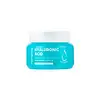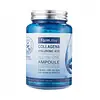What's inside
What's inside
 Key Ingredients
Key Ingredients

 Benefits
Benefits

 Concerns
Concerns

 Ingredients Side-by-side
Ingredients Side-by-side

Water
Skin ConditioningGlycerin
HumectantCetyl Ethylhexanoate
EmollientHyaluronic Acid
HumectantPropanediol
SolventPropylene Glycol
HumectantCaprylic/Capric Triglyceride
MaskingSodium Hyaluronate
HumectantStearic Acid
CleansingGlyceryl Stearate
EmollientPEG-100 Stearate
Sorbitan Stearate
EmulsifyingPolysorbate 60
EmulsifyingCetearyl Alcohol
EmollientDimethicone
EmollientCarbomer
Emulsion StabilisingDisodium EDTA
Betaine
HumectantAllantoin
Skin ConditioningChlorphenesin
Antimicrobial1,2-Hexanediol
Skin ConditioningPelargonium Graveolens Flower Oil
MaskingRose Flower Oil
MaskingSimmondsia Chinensis Seed Oil
EmollientCentella Asiatica Extract
CleansingSwiftlet Nest Extract
Skin ConditioningCaulerpa Lentillifera Extract
Laminaria Japonica Extract
Skin ProtectingChrysanthemum Indicum Callus Culture Extract
AntioxidantHamamelis Virginiana Extract
AntiseborrhoeicParfum
MaskingTriethanolamine
BufferingWater, Glycerin, Cetyl Ethylhexanoate, Hyaluronic Acid, Propanediol, Propylene Glycol, Caprylic/Capric Triglyceride, Sodium Hyaluronate, Stearic Acid, Glyceryl Stearate, PEG-100 Stearate, Sorbitan Stearate, Polysorbate 60, Cetearyl Alcohol, Dimethicone, Carbomer, Disodium EDTA, Betaine, Allantoin, Chlorphenesin, 1,2-Hexanediol, Pelargonium Graveolens Flower Oil, Rose Flower Oil, Simmondsia Chinensis Seed Oil, Centella Asiatica Extract, Swiftlet Nest Extract, Caulerpa Lentillifera Extract, Laminaria Japonica Extract, Chrysanthemum Indicum Callus Culture Extract, Hamamelis Virginiana Extract, Parfum, Triethanolamine
Water
Skin ConditioningHyaluronic Acid
HumectantButylene Glycol
HumectantNiacinamide
SmoothingHydrolyzed Collagen
EmollientGlycerin
HumectantPhenoxyethanol
PreservativeCaprylyl Glycol
EmollientPEG-60 Hydrogenated Castor Oil
EmulsifyingJojoba Esters
EmollientTocopheryl Acetate
AntioxidantAscorbyl Palmitate
AntioxidantLactose
HumectantCellulose
AbsorbentHydroxypropyl Methylcellulose
Emulsion StabilisingCarbomer
Emulsion StabilisingTriethanolamine
BufferingHamamelis Virginiana Extract
AntiseborrhoeicSimmondsia Chinensis Seed Extract
AbrasiveJania Rubens Extract
Skin ConditioningGlycyrrhiza Glabra Root Extract
BleachingCamellia Sinensis Leaf Extract
AntimicrobialXanthan Gum
EmulsifyingDisodium EDTA
Adenosine
Skin ConditioningParfum
MaskingWater, Hyaluronic Acid, Butylene Glycol, Niacinamide, Hydrolyzed Collagen, Glycerin, Phenoxyethanol, Caprylyl Glycol, PEG-60 Hydrogenated Castor Oil, Jojoba Esters, Tocopheryl Acetate, Ascorbyl Palmitate, Lactose, Cellulose, Hydroxypropyl Methylcellulose, Carbomer, Triethanolamine, Hamamelis Virginiana Extract, Simmondsia Chinensis Seed Extract, Jania Rubens Extract, Glycyrrhiza Glabra Root Extract, Camellia Sinensis Leaf Extract, Xanthan Gum, Disodium EDTA, Adenosine, Parfum
Ingredients Explained
These ingredients are found in both products.
Ingredients higher up in an ingredient list are typically present in a larger amount.
Carbomer is a polymer of acrylic acid. Its main role is to create a gel consistency.
A high amount of carbomer can cause pilling or balling up of products. Don't worry, most products contain 1% or less of carbomer.
Disodium EDTA plays a role in making products more stable by aiding other preservatives.
It is a chelating agent, meaning it neutralizes metal ions that may be found in a product.
Disodium EDTA is a salt of edetic acid and is found to be safe in cosmetic ingredients.
Learn more about Disodium EDTAGlycerin is already naturally found in your skin. It helps moisturize and protect your skin.
A study from 2016 found glycerin to be more effective as a humectant than AHAs and hyaluronic acid.
As a humectant, it helps the skin stay hydrated by pulling moisture to your skin. The low molecular weight of glycerin allows it to pull moisture into the deeper layers of your skin.
Hydrated skin improves your skin barrier; Your skin barrier helps protect against irritants and bacteria.
Glycerin has also been found to have antimicrobial and antiviral properties. Due to these properties, glycerin is often used in wound and burn treatments.
In cosmetics, glycerin is usually derived from plants such as soybean or palm. However, it can also be sourced from animals, such as tallow or animal fat.
This ingredient is organic, colorless, odorless, and non-toxic.
Glycerin is the name for this ingredient in American English. British English uses Glycerol/Glycerine.
Learn more about GlycerinHamamelis Virginiana Extract comes from the witch hazel plant.
Unless it is specified to be non-alcohol, many types of witch hazel ingredients are distilled in denatured alcohol.
Witch Hazel has astringent, anti-inflammatory, antioxidant, and antibacterial properties.
The tannin content of witch hazel constrict the appearance of pores by drying out proteins. Witch hazel water gets anti-inflammatory and antibacterial properties from its catechin and gallic acid content.
However, witch hazel may be skin-sensitizing due to the tannin and fragrance compounds.
North American Indigenous groups have used witch hazel to help treat inflammation for centuries.
Learn more about Hamamelis Virginiana ExtractHyaluronic acid is naturally found in healthy skin. It is a humectant, meaning it draws moisture to your skin.
This ingredient helps hydrate, soothe, and protect the skin.
What makes hyaluronic acid so hydrating? It has the capacity to bind or hold large amounts of water.
Fun fact: It is already naturally found in our bodies, such as the fluids of our eyes and our joints.
Studies find this ingredient to have anti-inflammatory and anti-microbial properties. This can help speed up wound-healing.
Hyaluronic acid can be irritating if the molecule has a low-molecular weight, or if the molecules are small.
One study found low-molecular weight hyaluronic acid to be pro-inflammatory, meaning some people may experience irritation. This is because our bodies use hyaluronic acid in the wound-healing process to signal to our bodies, via irritation, that something needs healing.
The same study found high-molecular weight hyaluronic acid to be anti-inflammatory.
These are some other common types of Hyaluronic Acid:
Learn more about Hyaluronic AcidParfum is a catch-all term for an ingredient or more that is used to give a scent to products.
Also called "fragrance", this ingredient can be a blend of hundreds of chemicals or plant oils. This means every product with "fragrance" or "parfum" in the ingredients list is a different mixture.
For instance, Habanolide is a proprietary trade name for a specific aroma chemical. When used as a fragrance ingredient in cosmetics, most aroma chemicals fall under the broad labeling category of “FRAGRANCE” or “PARFUM” according to EU and US regulations.
The term 'parfum' or 'fragrance' is not regulated in many countries. In many cases, it is up to the brand to define this term.
For instance, many brands choose to label themselves as "fragrance-free" because they are not using synthetic fragrances. However, their products may still contain ingredients such as essential oils that are considered a fragrance by INCI standards.
One example is Calendula flower extract. Calendula is an essential oil that still imparts a scent or 'fragrance'.
Depending on the blend, the ingredients in the mixture can cause allergies and sensitivities on the skin. Some ingredients that are known EU allergens include linalool and citronellol.
Parfum can also be used to mask or cover an unpleasant scent.
The bottom line is: not all fragrances/parfum/ingredients are created equally. If you are worried about fragrances, we recommend taking a closer look at an ingredient. And of course, we always recommend speaking with a professional.
Learn more about ParfumTriethanolamine is an emulsifier and pH adjuster. It is created using ethylene oxide and ammonia. This gives Triethanolamine a nitrogen core and a similar scent to ammonia.
As an emulsifier, it prevents ingredients from separating and enhances texture by adding volume to a product.
PH adjusters are common in cosmetic products. The pH of a product can affect the effectiveness of other ingredients. A product with a high pH may also irritate the skin.
Learn more about TriethanolamineWater. It's the most common cosmetic ingredient of all. You'll usually see it at the top of ingredient lists, meaning that it makes up the largest part of the product.
So why is it so popular? Water most often acts as a solvent - this means that it helps dissolve other ingredients into the formulation.
You'll also recognize water as that liquid we all need to stay alive. If you see this, drink a glass of water. Stay hydrated!
Learn more about Water